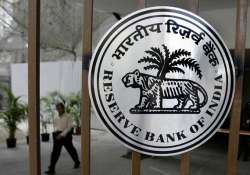RBI Q3 monetary policy review today; rate cut expected
Mumbai, Jan 29: An Interest rate cut is widely expected in the Reserve Bank of India (RBI)'s third quarter review of credit and monetary policy for the financial year 2012-13 on Tuesday after the government

Mumbai, Jan 29: An Interest rate cut is widely expected in the Reserve Bank of India (RBI)'s third quarter review of credit and monetary policy for the financial year 2012-13 on Tuesday after the government took steps to bring its finances under control and inflation moderated.
The RBI last cut rates in April 2012 by 0.5 per cent.
The central bank has maintained a tight monetary policy in view of the government's ballooning fiscal deficit and high inflation rates. However, in last month's guidance, it said there was a "reasonable likelihood" of policy easing in the January-March quarter.
Analysts say a convergence of data and government policies builds a compelling case for a much-desired interest rate cut.
The government has partially deregulated the price of diesel and limited the number of subsidised cooking gas cylinders per household per year. Finance Minister P. Chidambaram has said the budget deficit would be contained in the current fiscal to 5.3 percent of Gross Domestic Product (GDP).
The headline inflation is still above the RBI's comfort level but it has begun showing signs of easing. As measured by the wholesale price index, it fell to a three-year low of 7.18 percent in December.
And core inflation (headline inflation minus food and energy inflation which have a more direct impact on monetary policy action) has been falling. In December, it had reached a 33-month low of 4.24 percent.
Also, the Reserve Bank cannot ignore the fact that business confidence in Asia's third largest economy over the months has worsened. According to a survey by the Confederation of Indian Industry (CII), business confidence worsened during the October-December quarter due to high interest rates and infrastructure bottlenecks.
Another factor that may influence the RBI decision is the industrial production data, which had logged a negative 0.1 per cent growth year-on-year in November 2012.
The RBI last cut rates in April 2012 by 0.5 per cent.
The central bank has maintained a tight monetary policy in view of the government's ballooning fiscal deficit and high inflation rates. However, in last month's guidance, it said there was a "reasonable likelihood" of policy easing in the January-March quarter.
Analysts say a convergence of data and government policies builds a compelling case for a much-desired interest rate cut.
The government has partially deregulated the price of diesel and limited the number of subsidised cooking gas cylinders per household per year. Finance Minister P. Chidambaram has said the budget deficit would be contained in the current fiscal to 5.3 percent of Gross Domestic Product (GDP).
The headline inflation is still above the RBI's comfort level but it has begun showing signs of easing. As measured by the wholesale price index, it fell to a three-year low of 7.18 percent in December.
And core inflation (headline inflation minus food and energy inflation which have a more direct impact on monetary policy action) has been falling. In December, it had reached a 33-month low of 4.24 percent.
Also, the Reserve Bank cannot ignore the fact that business confidence in Asia's third largest economy over the months has worsened. According to a survey by the Confederation of Indian Industry (CII), business confidence worsened during the October-December quarter due to high interest rates and infrastructure bottlenecks.
Another factor that may influence the RBI decision is the industrial production data, which had logged a negative 0.1 per cent growth year-on-year in November 2012.